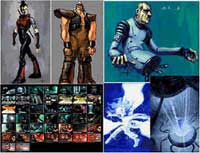
Working for Pixar
Pixar Animator Alex Orrelle Speaks Alex Orrelle talks with Israeli Animation Forum members about Pixar, Manex, Matrix 2 and more.
 About Alex: Alex Orrelle is a London-born, Israeli-raised animator. He has studied animation at the Academy of Art College in San Francisco, where he directed a group project CG short called "Freeware". The short won the Alias|Wavefront student competition. Alex went on to work at Manex Visual Effects, as a character animator for the Matrix sequels. His current job is at Pixar, where he serves as both character animator and storyboard artist.
About Alex: Alex Orrelle is a London-born, Israeli-raised animator. He has studied animation at the Academy of Art College in San Francisco, where he directed a group project CG short called "Freeware". The short won the Alias|Wavefront student competition. Alex went on to work at Manex Visual Effects, as a character animator for the Matrix sequels. His current job is at Pixar, where he serves as both character animator and storyboard artist. Working at Pixar:
hermonir: Hello everybody, hello Alex.aorrelle: Shalom from San Francisco
Phoebs: How did you get accepted to Pixar?
aorrelle: Getting into Pixar was a three year project. I studied at the academy of art in SF and took Pixarīs short film class there.In that course I got to know the teachers and made it clear to them that I want a job at Pixar... I had to prove myself worthy through working my ass off and exceeding expectations. Even if you are as good as animators at Pixar, it doesnīt mean you have a job there. Itīs very much about timing...
morobuse: What is your background? Traditional cell animation? Claymation? Life drawing? Tell us the secret."To get into Pixar you have to be good. Thereīs no secret."
aorrelle: My background is a lot of drawing. Since I was a kid I would draw, make home movies with my friends and a super-8, and even try to shoot animation. It was very unsuccessful but at least I tried. To get into Pixar you have to be good. Thereīs no secret. You have to love animation, love talking about it and understand what makes it so appealing...
galrt: Going to schools in the US is quite expensive in local standards. How did you handle it financially if you don't mind me asking?
aorrelle: School was very expensive for someone who canīt work. Itīs a privilege I owe to my parents.
Kfiram: I've always wondered how big studios like Pixar divide the work between artists. The general conception is that a modeler does nothing but model, a shading artist does shading alone, the guy in charge of LipSync doesn't animate the body, etc. Is that really the case? And if so, how come you're both character animator and storyboard artist? What exactly do you do anyway?
aorrelle: Great question. Pixar is constantly re-evaluating how artists are defined on a production. So much, in fact, that no two movies are made exactly the same way.Toy story was made by very few people. At that time, the modeler was also an animator, and the shader artist, and layout etc.But since Pixar got successful and the technology more complex, it became necessary to split up people into categories, mainly because the tools are too difficult to master on all separate tasks.I work in the shorts department and when I was hired, the head of story on the current short film was my storyboards teacher from school. So I got to work on the story as well, which is a big bonus for an animator...
Kfiram: Have you worked on "Mike's New Car"?
aorrelle: I just helped with the title animation on that, because I was working on a Buzz lightyear cereal TV commercial at the same time.If you want to search for it - itīs called "Buzz Blasts" and is a 30 second commercial.
hermonir: If people create animations for different characters, how do you keep the characters act the same, consistently throughout the movie? Is there an "animation sheet" for each character where the style is established for different moods, and people refer to it? Or is it just the directorīs job to keep everything consistent?
aorrelle: Animators are usually cast shots according to the animators specific strengths, like physical action or subtle emotional acting.There are sometimes, character leads, but no animator is married to one character for a whole movie.Itīs all the animators jobsī to keep animation consistent on characters. Thatīs why we have dailies - a daily review of the work thatīs been done the previous day, when everyone gets to comment on everyone elseīs work.
hermonir: What is the animation quota? How much final character animation does an animator produce in a week?
aorrelle: Four feet per week - about three seconds.
Phoebs: Do you use Renderman (Alfred)?
aorrelle: Yes.
hermonir: Pixar animator Victor Navone (creator of "Alien Song") is working on a new short called "Big Bang". I wish my finished films looked half as good as his animatic...
aorrelle: Victor is my office mate. Heīs been working on the animatic for six months already and has special permission from Pixar to make it independently.Donīt hold your breath, though. It will probably take him two years to make.
hermonir: Six months? What's taking so long?
aorrelle: He also has a full time job.Itīs really tough working at work and then spending nights and weekends on such an involved project.

Personal work:
galrt: is there a place we can see some of your personal stuff?aorrelle: Sorry - not yet. Iīll have a website later this year, though. Iīll keep you all posted.
Kfiram: What can you tell us about your personal films?
aorrelle: At the academy I made two hand drawn films and directed a CG short film.The first film (for the Pixar animated short film class) is called Soda (3.5 minutes) and itīs about a guy whoīs waiting for a subway train and gets in trouble with a soda vending machine.The second was called Lou (3 minutes) and was about a kid in a public urinal, who canīt reach the urinal. A cockroach called Lou tries to make a deal with him...The third, Freeware - you can read all about at ifilm:
http://www.ifilm.com/ifilm/product/film_info/0,3699,424515,00.html
Being inside the Matrix
Kfiram: What exactly did you do on the Matrix sequels?
aorrelle: At Manex, I was a character animator on R&D for Matrix 2 and 3, before I moved to Pixar. I also did previsualization, which I really enjoyed. Itīs basically rough 3D animation that conveys information about the complex live action shoot before it happens, so the editors can work on it before itīs shot.
Animation and employment tips
morobuse: What is the common mistakes with young inexperienced animators and how can one avoid them?aorrelle: The most common mistake of inexperienced animators is shutting themselves at home and not showing their work for critique, thinking that theyīll figure it out themselves.The second mistake is showing their work to EVERYONE, including their mother and never finishing the film.
jhones: From your experience, when creating a film intended to impress a potential employer - should I try to show a great deal of technical control, have a unique animation style and work on some complex models, or should I create something loose with a good idea?"The things youīre not good at - you donīt like doing anyway."
aorrelle: The only way to impress an employer is to show what youīre good at. In the unlikely chance that you are an incredible designer, modeler, shader, animator, rigging artist, cinematographer AND lighter - it will take you too long to make a film by yourself, to get a job.Itīs important to get a feeling of what you are strong at, so you can keep working on your strength - instead of trying to work on what youīre not naturally talented at.Youīll find out quickly that the things youīre not good at - you donīt like doing anyway.Example - if you love animating - you should make a very simple scene, even a film (IF you like making films. Not everyone does...). then your potential employer knows what to look at. Having a ton of effects, lights and camera moves usually makes people here detect that youīre trying to distract them from bad character animation.
3Dennis: Do you think drawing ability is important for work on visual effects? If I can't draw, what can I accomplish?
aorrelle: Just learn to draw.Thereīs no excuse not to know how to draw. As good as you are at effects and modeling and animation - you canīt see half your mistakes if you donīt understand good composition, good design and appealing shapes.Itīs just a fact. Sorry. I can recommend some books if youīre interested...
talotan: After writing dozens of scripts, and acknowledging that I'll never find the time to actually make them (as long as there's "real" work), I've come across a really astonishing script. The question is, should I try to involve outside sources to help with the production? If so, will I still have creative control?
aorrelle: The answer is tough: You canīt get anything off the ground alone - you need people who have what youīre missing. As far as creative control, if youīre afraid of someone walking in and taking over - you should be so lucky to at least get the funding for it. Itīs a negotiation. Like peace! You have to make "tough concession" for the other side to have any reason to help you.If you get the money for it yourself - you can control it.





